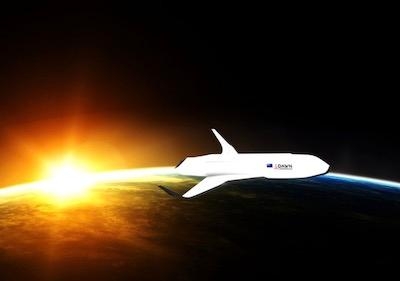Dawn Aerospace Platform Shows Promise
Dawn Aerospace is a Christchurch, New Zealand-based space technology concern with additional operations in the United States and the Netherlands. The company currently manufactures satellite propulsion systems and reusable, unmanned, suborbital spaceplanes.

On 05 April 2023, Dawn Aerospace announced it had successfully completed the first series of rocket-powered test-flights of its Mk-II Aurora spaceplane. The flight-test campaign was carried out at New Zealand’s Glentanner Aerodrome on 29, 30, and 31 March. The accomplishment occasions an important milestone in the Aurora platform’s development and advances the company’s stated mission of “revolutionizing space access.”
Previously, surrogate jet engines were used to vet the Mk-II Aurora spaceplane’s design and the integrity of its construction. The transition to rocket engines proved successful, as all flight-test objectives were met.
The Aurora spaceplane—as its moniker suggests—is designed to operate, in part, after the fashion of a conventional aircraft. Unlike traditional rockets, which ascend from launch-pads and return to Earth under parachute, Aurora takes off and lands horizontally, departing from and returning to standard airport runways.
Dawn Aerospace CEO Stefan Powell stated: "To have demonstrated rapid reusability in the first tests is proof of our core philosophy, and confirmation that rocket-powered vehicles can be operated just like commercial jet aircraft. This fact allows us to rapidly test now, but in the future, it will completely revolutionize the economics of space access."
Mr. Powell added: “These flights were a monumental achievement for Dawn Aerospace, and the result of years of hard work from the team. After conducting three tests in three days, we believe Mk-II is the most rapidly reusable rocket-powered aircraft in operation.”
Rather than attempting to plumb the Mk-II’s maximum speed or altitude, the recently-completed flight-test campaign set out to validate key vehicle systems and capabilities—such as the performance of the new rocket engine. Explorations of the edges of the Mk-II’s performance envelope will be pursued by degrees over the course of future test-flights. Under jet power, the Mk-II Aurora reached altitudes of six-thousand-feet and speeds of approximately 170-knots. During future commercial operations, the spaceplane will climb to an altitude of 330,000-feet (one-hundred-kilometers/the Kármán line).

Dawn Aerospace intends for its Aurora spaceplane—by dint of the vehicle’s fully and rapidly reusable first-stage booster—a be the first reusable space-launch platform capable of conducting multiple daily flights.
Upon the successful completion of the Mk-II Aurora program, Dawn Aerospace plans to develop the Mk-III, a two-stage orbital vehicle capable of delivering a 551-pound (250-kilogram) satellite to Low Earth Orbit (LEO).
Mr. Powell concluded: “The vast majority of our industry’s carbon footprint is created in the manufacturing of rockets, not the fuel efficiency. Our orbital vehicle, Mk-III, is designed to be 96-percent reusable. This is key to delivering on our vision of a sustainable and future-proof space industry.”
 ANN's Daily Aero-Term (05.09.24): Hold Procedure
ANN's Daily Aero-Term (05.09.24): Hold Procedure ANN's Daily Aero-Term (05.06.24): Altitude Readout
ANN's Daily Aero-Term (05.06.24): Altitude Readout ANN's Daily Aero-Linx (05.06.24)
ANN's Daily Aero-Linx (05.06.24) Airborne-NextGen 05.07.24: AI-Piloted F-16, AgEagle, 1st 2 WorldView Sats
Airborne-NextGen 05.07.24: AI-Piloted F-16, AgEagle, 1st 2 WorldView Sats Aero-News: Quote of the Day (05.07.24)
Aero-News: Quote of the Day (05.07.24)




